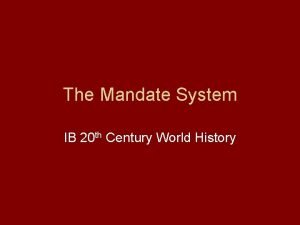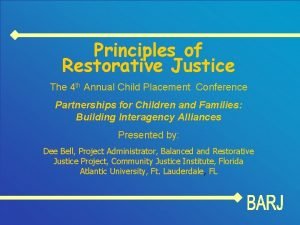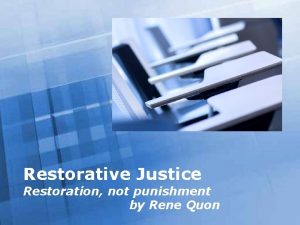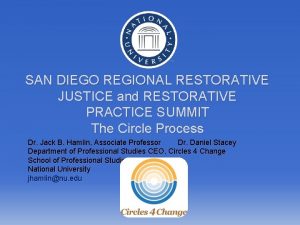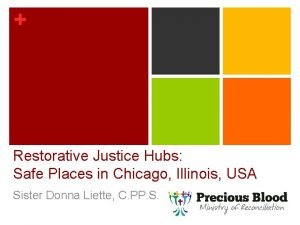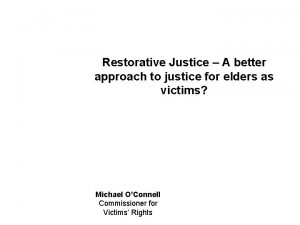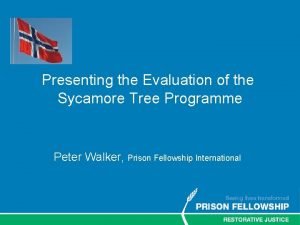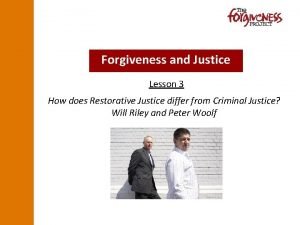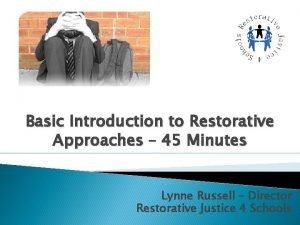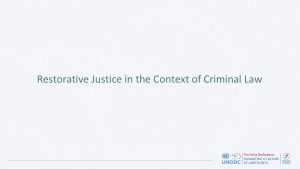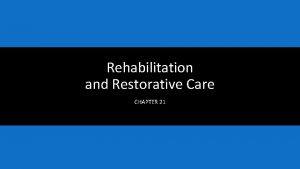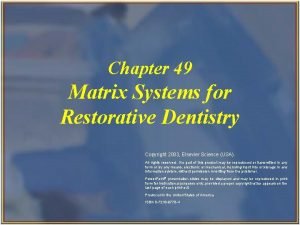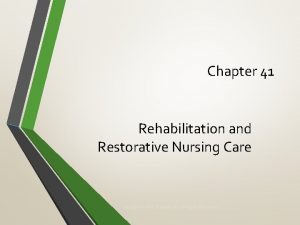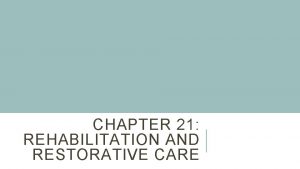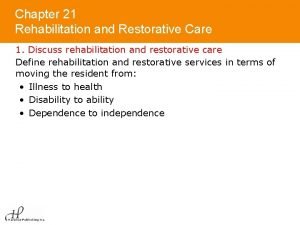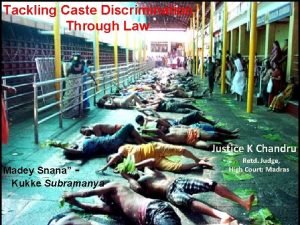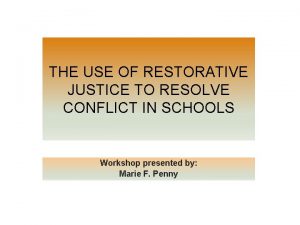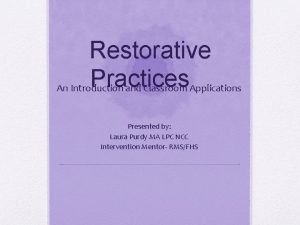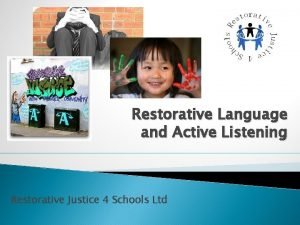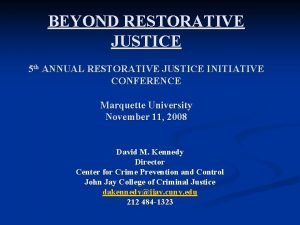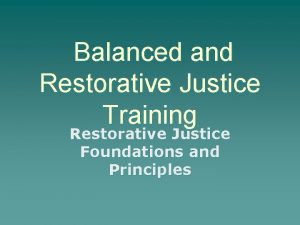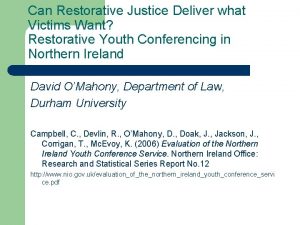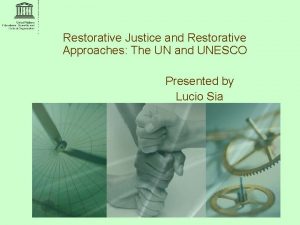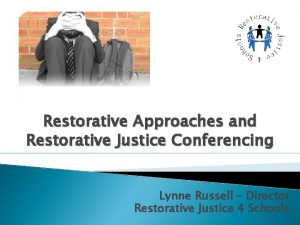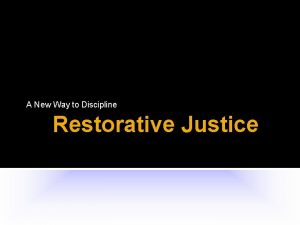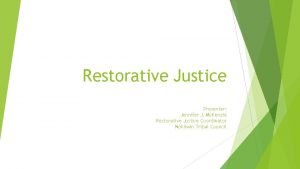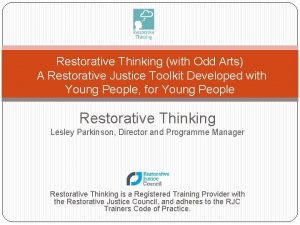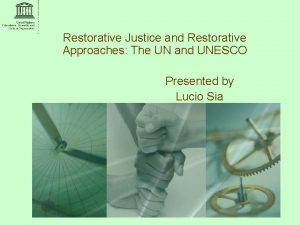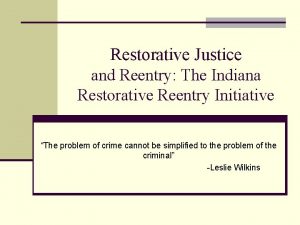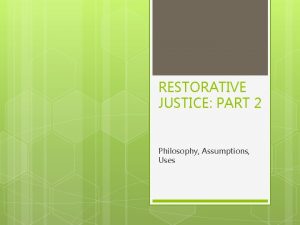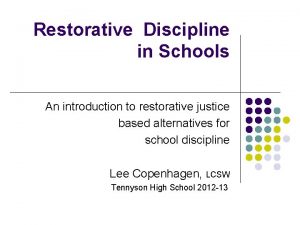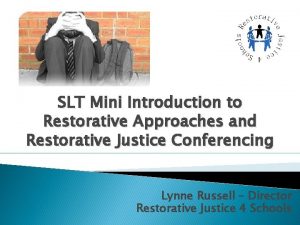Chapter 10 Economic Restorative Justice Reparations Introduction Community



























- Slides: 27

Chapter 10 Economic & Restorative Justice Reparations

Introduction Community justice: a philosophy that uses community stakeholders to control & reduce crime & rebuild community relationships through community policing, community courts & restorative justice Restorative justice: a sentencing philosophy that emphasizes the offender taking responsibility to repair the harm done to the victim & the surrounding community

Restorative Justice Principles RJ is community-based & combines mainstream American criminal justice with indigenous justice practiced by Native Americans RJ focuses on the victim, the offender, & the community, rather than just punishing the offender RJ uses reintegrative shaming rather than stigmatization Reintegrative shaming allows the victim & community to disapprove of the criminal behavior but seeks to repair the weakened social bonds caused by the crime

Restorative Justice Principles All forms of RJ share 6 commonalities: • At least 1 session is held in the community, with the goal of allowing victims to communicate how the crime affected them • A reparative plan is developed & accepted by the victim & the offender • Victim & offenders volunteer to participate • Parties rely on community partners & volunteers for help • Offenders accept responsibility for their crime, admit guilt, & agree to comply with the reparation plan • While RJ can take place in jails & prisons, most forms are community-based & are an alternative to traditional court processing or as part of diversion

Victim & Offender Mediation (VOM) VOM has existed in U. S. since early 1980 s; there are thousands of programs worldwide Victims agree to participate in order to seek restitution, oversee punishment, & share their grief with the offender Many victims report satisfaction with case outcomes, are more likely to get restitution, & are less fearful of being revictimized There are concerns VOM gives victims’ perspective more free reign & offenders’ perspective is not addressed enough No strong evidence that VOM reduces recidivism Between 40 to 60% of victims refuse to participate in VOM

Reparation Boards Reparation boards have existed in the juvenile justice system since 1920 s Boards mediate between the court & the offender and may or may not involve the victim They meet after the offender is convicted to decide how offender will repair harm & reform their conduct Volunteers agree to mentor & supervise the offender Board reports to the court on offender’s compliance & recommend sanctions if the offender violates reparation plan

Family Group Conferencing Used primarily when the victim & offender come from the same family or close-knit group, the goal is to strengthen families Conference includes not only the victim & offender, but also family members Typically used in juvenile cases Requires offender to take responsibility Participation is voluntary for all involved

Sentencing Circles Circles are based on tribal justice & rely on reintegrative shaming Circles consist of offender, victim, family, friends, coworkers, social service personnel, & interested community members Purpose is to arrive at consensus of how justice can be achieved Of all RJ programs, circles involve largest number of participants & are most organized Most effective in smaller communities

Effectiveness of Restorative Justice Methods Measures of RJ include: • Satisfaction with the outcome/process • Payment of restitution • Cost savings Ø Studies show restitution more likely to actually happen as part of an RJ program than tradition court processing Ø RJ is less likely to be accepted by victims of violent crimes than victims of property crimes

Effectiveness of Restorative Justice Methods, Cont’d. Victims’ concerns about RJ are: • Some victim’s groups find RJ focused on offenders • Some criticize RJ for its emphasis on reintegrative shaming, rather than retribution & stigmatization • Many victims find it difficult to advocate on their own and RJ is additional pressure Ø Evaluations of RJ: • Positive impact on recidivism of juvenile offenders • Less successful in reducing recidivism of adult offenders

Restitution Restitution: court-ordered payment by the offender to the victim (or the victim’s family) to cover the tangible losses that occurred during or following the crime Restitution has a long history around the world The victim rights movement in the 1960 s put the spotlight on the need for judges to order restitution

Restitution, Cont’d. Congress passed 3 statutes in the 1990 s to increase the collection of restitution Losses by victims available for compensation include: • Lost income, medical expenses, transportation to court, child care, counseling sessions, sexual assault exams, HIV testing, moving expenses, travel & meal expenses, & burial expenses Eligible parties include: victims, the victim’s family, & organizations that provide care, shelter, or counseling Victims typically apply for restitution through prosecutor’s office, press charges, & agree to testify

Restitution Problems associated with restitution are: • Underutilization • restitution is ordered in only 10% of felony convictions & 22% of misdemeanors • The lack of victim participation in the system & general lack of knowledge about restitution • Defendant’s indigence • Determining the proper amount • Collecting restitution

Indigent Offenders An indigent defendant who cannot pay restitution cannot be cited for contempt or sent to prison If a defendant can afford but refuses to pay restitution, he or she may be incarcerated depending on the jurisdiction’s laws Declaring bankruptcy does not excuse offenders from paying restitution

Determining the Restitution Amount In RJ cases, it is determined at the mediation session In traditional court cases, the judge sets the amount Officers can suggest an amount in a PSI report Amount based on: • offender’s financial obligations & ability to pay • whether the victim was insured or was partially at fault • expenses the victim incurred because of the crime (prosecutor must establish the amount of harm beyond a preponderance of the evidence) • the harms & costs that qualify for restitution • the effect of a plea agreement

Collecting Restitution Probation offices, day reporting centers, & restitution centers collect restitution, determine the installment payment schedule & get the funds to the victim Only about a third to half of felony offenders pay full restitution before end of their sentence Some systems will not an incarcerated offender if restitution is not paid

Community Service Community Service: unpaid service to the public to compensate for harm done by the offender Typically ordered by judge as part of probation Most frequent types of community service: picking up roadside litter, doing landscape maintenance, removing litter or graffiti, painting buildings Community service began in the U. S. in 1966 in Alameda County, California In the U. S. , it has developed as an alternative to fines or a condition of probation

Probationers who were ordered to community service, restitution, and treatment

Community Service, Cont’d. The U. S. does not follow the English model of allowing community service to serve as an acceptable alternative to imprisonment Community service is both punitive and rehabilitative Good alternative for indigent offenders who cannot afford monetary sanctions & wealthy offenders where such sanctions are not meaningful States differ in how often community service is mandated, & is seldom used as a sole sanction The offender’s employment status must be considered in determining their schedule

Effectiveness of Community Service Many nonprofit organizations benefit from the labor provided by offenders Completion rates vary, in part depending on strength of enforcement While little research has been done regarding effectiveness, community service has wide public support Important questions about community service: • • What is its purpose: diversion, reduce recidivism, both? Should it be used instead of or with other sanctions? Should it be expanded for prison-bound offenders? How is its value calculated compared to days in jail or fines?

Fines Fine: a monetary sanction imposed by the judge, the amount depending on the severity of the offense Two types of fines: fixed fines & day fines 90% of fines go to victim/witness assistance programs or victim compensation funds. A fine is viewed as a punishment & can be imposed as sole penalty or one of other penalties Fines in U. S. are underused & their collection is not well enforced

Fines, Cont’d. Fines are ordered in 25% of state felony cases & 13% of federal cases Seldom used in the U. S. as the sole penalty, but are used as primary penalty for organizational or corporate defendants In Bearden v. Georgia (1983), the Supreme Court held that probation cannot be revoked solely due to an offender’s inability to pay a fine or restitution Unwillingness to pay may result in revocation

Day Fines Day fines, or structured fines: court fines figured as multiples of the offender’s daily income & provide the same percentage of financial hardship to each offender A low income offender & a wealthy offender convicted of the same offense, with the same criminal history & risk factors, would pay different amounts because their earning are different Day fines impose the same degree of financial hardship on each offender

Fees Fee: a court-imposed reimbursement that the offender pays for the administration of the criminal justice system Acquitted defendants do not pay fees Fees are not considered punitive & indigent defendants cannot be required to pay them Typical fees or “costs” are assessed for: • • DNA, drug, & alcohol testing Diagnostic testing Inpatient & outpatient treatment Prosecution/court costs Repayment of fees for appointed counsel Community supervision fees EM/GPS

Forfeitures Forfeiture: a government seizure of illegally obtained property or used in connection with illegal activity, & can be either criminal or civil In criminal cases, it occurs after conviction In civil cases, the burden of proof is by preponderance of evidence Purpose is to make sure offenders cannot keep illegal property & discourage the use of homes & businesses to conduct crimes Not considered punishment, but (per 8 th Amendment’s ban on excessive fines) cannot be grossly disproportionate to the seriousness of the offense

Residential Community Facility An AWOL soldier, Derik Hembree, pled guilty in 2011 to violating a custody order after absconding with his 1 month old baby. He left the baby unharmed at an Oklahoma fire station. Hembree is a combat veteran, and, according to his attorney, may have been suffering from PTSD at the time of his offense. Hembree was sentenced to 2 years in a community corrections facility. http: //www. gazette. com/common/printer/vi ew. php? db=colgazette&id=130559

Celebrity Doing Community Service Rap artist Snoop Dog was sentenced to 800 hours of community service & 5 years probation in 2007 for felony gun possession & marijuana charges. Later that year he was sentenced to another 160 hours of community service & a $10, 000 donation to charity for felony possession of a dangerous weapon.
 Restorative justice community action
Restorative justice community action Belgium reparations
Belgium reparations Principle of restorative justice
Principle of restorative justice Restorative justice powerpoint template
Restorative justice powerpoint template San diego restorative justice
San diego restorative justice Restorative justice hubs chicago
Restorative justice hubs chicago Pros and cons of restorative justice
Pros and cons of restorative justice Sycamore tree victim awareness programme
Sycamore tree victim awareness programme Peter woolf and will riley
Peter woolf and will riley Restorative justice script
Restorative justice script Restorative justice
Restorative justice Principles of restorative justice
Principles of restorative justice Chapter 21 rehabilitation and restorative care
Chapter 21 rehabilitation and restorative care Chapter 49 matrix systems for restorative dentistry
Chapter 49 matrix systems for restorative dentistry Chapter 41 rehabilitation and restorative nursing care
Chapter 41 rehabilitation and restorative nursing care Chapter 21 rehabilitation and restorative care
Chapter 21 rehabilitation and restorative care Rehabilitation and restorative care chapter 21
Rehabilitation and restorative care chapter 21 Chapter 49 matrix systems for restorative dentistry
Chapter 49 matrix systems for restorative dentistry Justice k chandru community
Justice k chandru community Economic growth vs economic development
Economic growth vs economic development Prof. meier and baldwin
Prof. meier and baldwin Chapter 1 lesson 2 our economic choices worksheet answers
Chapter 1 lesson 2 our economic choices worksheet answers Canadian community economic development network
Canadian community economic development network Restorative practice circle questions
Restorative practice circle questions Circle norms
Circle norms Restorative language
Restorative language Auxillary dental materials
Auxillary dental materials Restorative instruments in dentistry
Restorative instruments in dentistry

